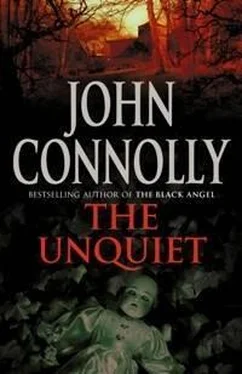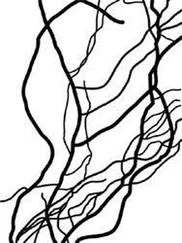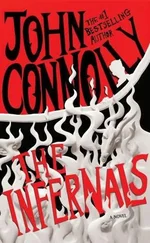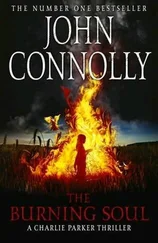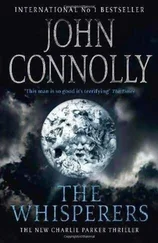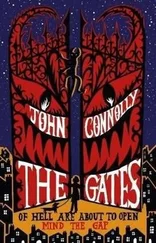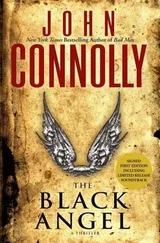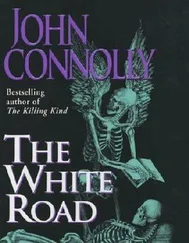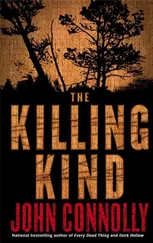The red Jackman station house stood by the railway line that cut through the town, but it was now privately owned. The main bridge in town was being repaired, so a detour took us over a temporary structure and into the township of Moose River. On the right was the modest Moose River Congregational Church, which bore the same relationship to St. Anthony’s as the local Little League team bore to the Red Sox.
Eventually, we came to the sign for Holden Cemetery, across from the Windfall Outdoor Center, its blue school buses, now empty, lined up sleepily outside. A dirt-and-stone road led down to the cemetery, but it looked steep and slick with ice, so we left the car at the top of the road and walked the rest of the way. The road led past a frozen pond on one side and a patch of beaver bog on the other, before the gravestones of the cemetery appeared on a hill to the left. It was small, and bordered by a wire fence, with an unlocked gate wide enough for one person to pass through at a time. The graves dated as far back as the nineteenth century, probably to the days when this was still just a settlement.
I looked at the five stones nearest the gate, three large stones, two small. The first read “Hattie E., wife of John F. Childs” and gave the dates of her birth and death: April 11, 1865, and November 26, 1891. Beside her stood the two smaller stones: Clara M. and Vinal F. According to the stone, Clara M. was born on August 16, 1895, and died just over a month later on September 30, 1895. Vinal F.’s time on this earth was even briefer: born on September 5, 1903, he was dead by September 28. The fourth stone was that of Lillian L., John’s second wife and presumably the mother of Clara and Vinal. She was born on July 11, 1873, and died less than a year after her son, on May 16, 1904. The last stone was that of John F. Childs himself, born September 8, 1860, and died, having outlived two wives and two children, March 18, 1935. There were no other stones nearby. I wondered if John F. had been the last of his line. Here, in this tiny cemetery, the story of his life was laid bare in the space of five carved pieces of rock.
But the stone we were looking for stood in the farthest southern corner of the cemetery. There were no names upon it, and no dates of birth or death. It read only the children of gilead, followed by the same word carved three times:
INFANT
INFANT
INFANT
and a plea to God to have mercy on their souls. As unbaptized children, they would originally have been laid to rest outside the cemetery, but it was clear that at some point in the past the position of the cemetery fence had been discreetly altered in this corner, and the Children of Gilead now lay within its boundaries. It said a lot about the people of the town that quietly, and without fuss, they had embraced these lost infants and allowed them to rest within the precincts of the graveyard.
“What happened to the men who did this?” asked Angel. I looked at him and saw the grief etched on his face.
“Men and women,” I corrected him. “The women must have known and colluded in what happened, for whatever reason. Two of those children died of unknown causes, but one was stabbed with a knitting needle shortly after birth. You ever hear of a man stabbing a child with a knitting needle? No, the women covered it up, whether out of fear or shame, or something else. I don’t think Dubus was lying about that much. Nobody was ever charged. The authorities examined three girls and confirmed that they’d given birth at some point in the recent past, but there was no evidence to connect those births with the bodies that they found. The community got together and claimed that the children were given up for private adoption. There was no paperwork for the births, which was a crime in itself, but one that nobody felt the urge to prosecute. Dubus told the investigators that the kids were sent to somewhere in Utah. A car came along, he said, collected them, then disappeared into the night. That was the story, and it was only years later that he recanted and claimed that the mothers of the girls who had given birth had killed the infants. Anyway, a week or so after the bodies were found, the community had already broken up, and people were going their separate ways.”
“Free to abuse somewhere else,” said Angel.
I didn’t reply. What was there to say, particularly to Angel, who had been a victim of such abuse himself, farmed out by his father to men who took their pleasures from the body of a child? That was why he was here now, in this cold cemetery in a remote northern town. That was why they were both here, these hunters among hunters. It was no longer a question of money for them, or their own convenience. That might once have been true, but it was true no longer. They were here now for the same reason that I was: because to ignore what had happened to children in the recent and distant pasts, to turn away and look elsewhere because it was easier to do so, was to be an accomplice to the crimes that were committed. To refuse to delve deeper would be to collude with the offenders.
“Somebody’s tended to this grave,” said Angel.
He was right. There were no weeds, and the grass had been cut back so that it would not obscure the marker. Even the words on the stone had been enhanced with black paint so that they would stand out.
“Who takes care of a fifty-year-old grave?” he asked.
“Maybe the man who now owns Gilead,” I replied. “Let’s go ask him.”
About five miles along the 201, beyond Moose River and past the Sandy Bay town line, a sign pointed north to the Bald Mountain Hiking Trail, and I knew that we were nearing Gilead. Without Angel’s prior knowledge, the site itself would have been difficult to find. The road we took had no name. It was marked only by a sign reading private property and, as Angel had said, an additional warning listing those who were particularly unwelcome. About a half mile up the road was a gate. It was locked, and a fence disappeared into the forest on either side.
“ Gilead ’s in there,” said Angel, pointing north into the woods. “Maybe another half mile or more.”
“And the house?”
“Same distance, but straight up the road. You can see it from farther up that track.” He pointed to a rutted dirt trail that followed the fence southeast.
I pulled the car to the side of the road. We climbed over the gate and immediately cut into the forest.
We had walked for fifteen or twenty minutes when we came to the clearing.
Most of the buildings still remained. In a place where wood was the main building material, Lumley had chosen to use stone for a number of the houses, so confident was he that his ideal community would last. The dwellings varied in size from two-room cottages to larger structures comfortably capable of housing families of six or more. Most had fallen into ruin, and some had clearly been burned, but one appeared to have been restored to some degree. It had a roof, and its four windows were barred. The front door, a solid piece of rough-hewn oak, was locked. All told, the community could not have numbered more than a dozen families at its peak. There were many such places in Maine: forgotten villages, towns that had withered away and died, settlements founded on misplaced faith in a charismatic leader. I thought of the ruins of Sanctuary, out on Casco Bay, and of Faulkner and his slaughtered flock in Aroostook. Gilead was another in a long and ignominious line of failed ventures, doomed by unscrupulous men and base instincts.
And above it all loomed the great steeple of the Savior’s Church, Lumley’s rival to St. Anthony’s. The walls had been built, the steeple raised, but the roof had never been placed upon it, and no one had ever worshiped within its walls. It was less a tribute to God than a monument to one man’s vanity. Now the forest had claimed it for its own. It was smothered in ivy, so that it appeared as though nature itself had built it, creating a temple from leaves and tendrils, with grass and weeds for its floor and a tree for a tabernacle, for a shagbark hickory had grown where the altar might have stood, spreading its bare arms like the skeletal remains of a deranged preacher, stripped of his flesh by the cold wind as he railed against the world, his bones browned by the actions of the sun and the rain.
Читать дальше
